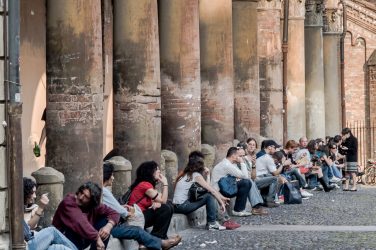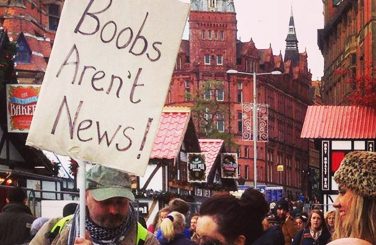For many of us, social distancing has been a lonely time. E&M‘s Nicoletta Enria shares with us the art and artists that have been keeping her company in the past months, and reminds us of the power of creative imagination in difficult times.
Four months into a lockdown-imposed fortress of solitude I find myself seeking comfort and company wherever I can. From naming all my plants (Jean-Claude has been struggling with the heat wave but I think he’ll pull through) to gasping when I hear a lyric about coronavirus and lockdown in a song, desperate to form a bond over a common experience through my headphones, or travelling back to the future with Marty, wishing I could warn 1955 what a shitstorm 2020 will be. Or more seriously, when listening to my boyfriend’s music on Spotify or on the radio, where I found myself feeling soothed by a voice that has given me love, stability and comfort for years, whom I was forced to only hear from a distance for five months. These days I find art to have become my lifeline. Grappling with the world from my room, feeling social anxiety and the feeling that I have severed all social connections and will have lost all social skills to rebuild any – I turn to art to remind myself I in fact am not alone.
These days, we are all barricaded at home, either alone or with loved ones, strangers, howling kids, broody teens, confused dogs, unphased cats, trying to reckon with the seemingly never-ending uncertainty about our future, and how institutionally unfair and violent our societies are towards vulnerable, marginalised communities. Black Lives Matter gaining the attention it so desperately deserved, has been oaxing white people out of a cave of lethargy and to look inwardly on how we must take action to dismantle the white supremacy we created, benefit from and uphold, and reflect on why we are sitting a bit too comfortably with it. And we must do all this from our homes that have come to encase our whole worlds, or through protesting with others from afar – keeping the 2 metres which increasingly feel like an abyss of loneliness. Meanwhile, COVID-19 is still ravaging across the world, death remains a constant that some communities are having to reckon with at an unprecedented rate. And all this from your bedroom. Experts warn we are undergoing and will continue to undergo a global mental health crisis at unprecedented rates. I am tired of living in unprecedented times.
In my studies, I have always been fascinated by the power of art to stimulate empathy, and the political significance of this. We all draw different things from different artworks, they tell us about new experiences or inform or reinforce our feelings about our own. Therefore, I will not tell you what artists will help you with your distinctive experience of the world today, but I will tell you my experience of using art to navigate my corona-alienation.
1. On solitude
A little framed replica of an Edward Hoppers’ infamous Nighthawks hangs on top of my bed. Edward Hopper, the corona-artist-before-corona’s characters sit socially distanced in a bar, looking pensive and alone. I can’t help but feel angry at their distance, they were allowed to be close then back then – if I could go back in time I’d go back to the dirtiest and brush past every germy stranger I could find. How could they be so reckless and pass up on an opportunity like this? Nonetheless, the lonely drinkers feel like good company, other seasoned lonely souls, looking down at a disappointing glass of whatever.
One of my favourite lockdown discoveries is Prudence Flint. Her beautiful portrait of semi-nude women performing the most mundane activities: showering, lying in bed, yet these paintings mean so much more to me. Yet these characters express so much more than that, I feel the magnitude of their emotions when I cast my eyes on them. Flint, on the great women artists podcast, talks about the weight of the burden of society womxn carry, and I feel this heavy emotional burden on my skin as I glance at these stunning images.
2. On subversion
I love images of mundanity, it reminds me of the power of normality, and how precious this time that feels frozen and wasted actually is. Lubaina Himid’s epic The Lock & Le Redeur uses images of mundanity to subvert, provoke and excite – to remind us the social potential of a moment that feels stagnant. In this painting, she subverts Picasso’s female figures into black women, depicted in scenes that are extraordinary yet comical and absurd, but also still at home. This reversal of Picasso’s notoriously misogynistic and racist portrayal of femininity is a powerful reminder of diversifying representation and deconstructing white cis-femininity as the norm. In the painting, the womxn are holding the men, adding onto Flint’s previous depiction and reminding of the extra burdens black womxn carry. All under the guise of domestic normality.
3. On-line
Online, instagram accounts such as art of social distancing provide beautiful visual depictions of how different people perceive social distancing. I love realising that I’m not alone in being tormented by this concept, and how I savour the luxury of proximity to strangers . Along similar lines, one of my absolute favourites has been counterpoints art’s postcards in isolation: a different form of exile, a series of artists of displaced heritage reflecting on isolation and exile. This series gracefully chips away at a dichotomy of refugee and non-refugee that our society loves to uphold, without erasing the unequal power relations and differences of experience. This one below is a personal favourite, on how we cannot know the emotions behind the mask, and the distance and alienation intrinsic in wearing one.
4. On company
A major source of company has been fiction, creating other worlds where new characters and fully-rounded characters nestled me into a faux corona-free existence. Reading Candice Carty-William’s Queenie, I fell in love and laughed with the characters, navigating Queenie’s struggles with mental health, heartbreak and injustices and experiences I will never be able to understand but must do better at educating myself on. Jonathan Bazzi’s Febbre took me to reckoning with HIV in the outskirts of Milan, reflecting on the violence of the stigma of disease. Similarly, where would I be without the hilarious and warm company of Ilana and Abi from Broad City, living vicariously through Dennis Rodman’s partying in the Last Dance and Sorrentino’s debauchery in the Great Beauty, or modelling all my lockdown purchases after new style icon Carole Baskin.
One of my favourite songs ‘il cielo in una stanza’ (the sky in a room)’s first lyrics read, “when you’re with me I feel these walls no longer exist”. Art has done just that, helping the walls of the house feel a little less oppressive and making this extensive strangeness, solitude and difficulty a bit more bearable and, dare I say, liveable.
Cover photo: Visuals (Unsplash), Unsplash licence










